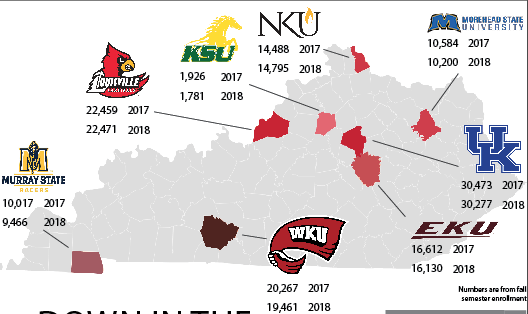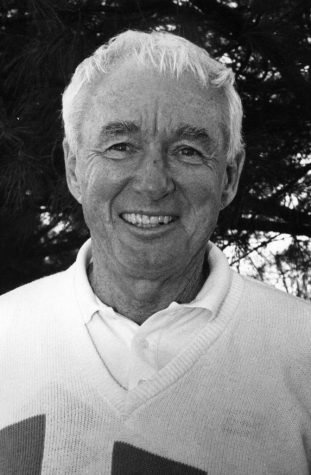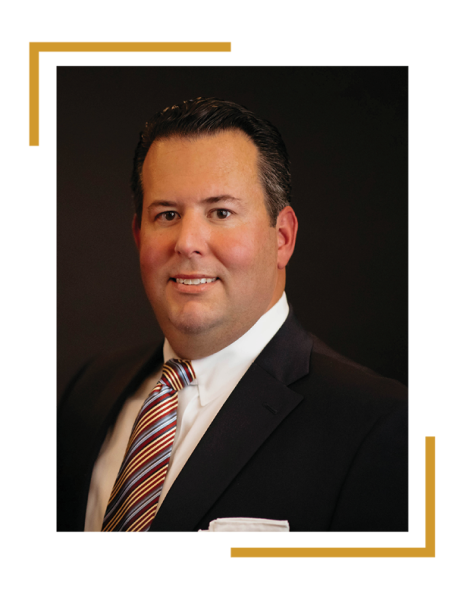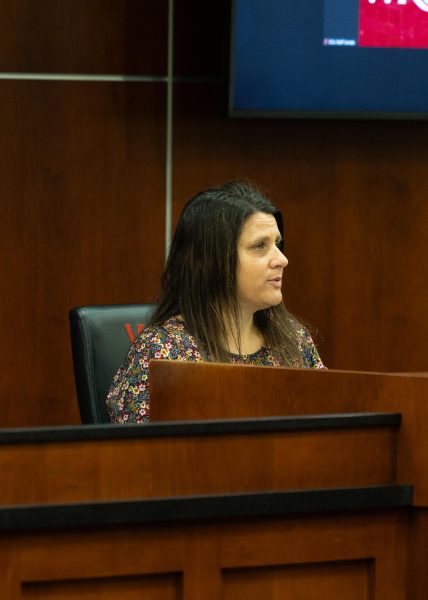WKU’s enrollment decline proves to be state-wide trend
February 5, 2019
In most public four-year Kentucky universities, overall enrollment declined from the 2017-18 academic year to 2018-19, and for universities such as WKU, enrollment numbers are lower than they were a decade ago, according to data published by the Kentucky Council on Postsecondary Education.
WKU, Murray State University, Northern Kentucky University and Kentucky State University all currently have lower enrollment than a decade ago in the 2008-2009 academic year. The data showed enrollment numbers for every academic year since 2008.
WKU enrollment has been in decline since the 2012-13 academic year from 21,124 to 19,461, an 8 percent decrease.
// <![CDATA[ // <![CDATA[ // &lt;![CDATA[ !function(){“use strict”;window.addEventListener(“message”,function(a){if(void 0!==a.data[“datawrapper-height”])for(var t in a.data[“datawrapper-height”]){var e=document.getElementById(“datawrapper-chart-“+t);e&amp;&amp;(e.style.height=a.data[“datawrapper-height”][t]+”px”)}})}(); // ]]&gt; // ]]> // ]]> For the 2018-19 academic year, Northern Kentucky University and the University of Louisville had a slight increase in enrollment, while all other public four-year universities showed a decline from the previous academic year, including WKU, which had the third-highest enrollment.
The University of Kentucky reported the highest enrollment numbers, and the University of Louisville had the second-highest.
Declining enrollment has been a key issue addressed by WKU President Timothy Caboni through the implementation of his 10-year strategic plan. The plan was approved by the Board of Regents in August 2018 and aims to improve student enrollment and retention.
To accompany the strategic plan, several campus construction projects have been initiated, including the first-year village and WKU Commons. Both of these projects are intended to make WKU more appealing to prospective students and to improve the student experience.
Enrollment at WKU for first-time students dropped 3.8 percent from 3,854 in 2016-17 to 3,706 students in 2017-18, which makes up about 18 percent of the total student population.
Again, WKU was not alone in this trend. Among all four-year public institutions, there was a 2.6 percent drop in first-time enrollment from 25,151 to 24,492 students. Information for first-time students was not available for the 2018-19 year.
Last week, Caboni announced to faculty and staff that retention for first-time, first-year students had increased between the fall and spring semesters. While he said they are preliminary numbers, he credited the increase to several institutions such as the Kelly M. Burch Institute and the Intercultural Student Engagement Center, which both address retention and student success.
// <![CDATA[ // <![CDATA[ // &lt;![CDATA[ // &amp;lt;![CDATA[ // &amp;amp;lt;![CDATA[ // &amp;amp;amp;lt;![CDATA[ // &amp;amp;amp;amp;lt;![CDATA[ !function(){“use strict”;window.addEventListener(“message”,function(a){if(void 0!==a.data[“datawrapper-height”])for(var t in a.data[“datawrapper-height”]){var e=document.getElementById(“datawrapper-chart-“+t);e&amp;amp;amp;amp;amp;&amp;amp;amp;amp;amp;(e.style.height=a.data[“datawrapper-height”][t]+”px”)}})}(); // ]]&amp;amp;amp;amp;gt; // ]]&amp;amp;amp;gt; // ]]&amp;amp;gt; // ]]&amp;gt; // ]]&gt; // ]]> // ]]> // <![CDATA[ // <![CDATA[ // &lt;![CDATA[ // &amp;lt;![CDATA[ // &amp;amp;lt;![CDATA[ // &amp;amp;amp;lt;![CDATA[ // &amp;amp;amp;amp;lt;![CDATA[ !function(){“use strict”;window.addEventListener(“message”,function(a){if(void 0!==a.data[“datawrapper-height”])for(var t in a.data[“datawrapper-height”]){var e=document.getElementById(“datawrapper-chart-“+t);e&amp;amp;amp;amp;amp;&amp;amp;amp;amp;amp;(e.style.height=a.data[“datawrapper-height”][t]+”px”)}})}(); // ]]&amp;amp;amp;amp;gt; // ]]&amp;amp;amp;gt; // ]]&amp;amp;gt; // ]]&amp;gt; // ]]&gt; // ]]> // ]]>
Enrollment in foreign language, literature and linguistics majors at WKU dropped from 100 to 85 students between 2016-17 to 2017-18 and stayed at 85 for the current academic year. There was a 5.67 percent drop in enrollment in those majors among all four-year public institutions from 716 to 656 students.
Currently no public four-year Kentucky universities include foreign language courses in general education requirements, according to respective general education information.
In December 2017, WKU removed the foreign language requirement for graduation. Since then, the French department dropped to one faculty member and announced the French major would no longer be offered by Fall 2021 due to a lack in enrollment.
International enrollment also decreased by 14 percent among all four-year public universities from 5,819 students in 2016-17 to 5,003 students in 2017-18. At WKU alone, international enrollment dropped by 28.57 percent from 2016-17 to 2017-18 from 1,169 to 835.
In a Herald editorial board meeting, Caboni estimated international enrollment is about 400 students. Exact data on international enrollment was not available for the 2018-19 academic year.
// <![CDATA[ // <![CDATA[ // &lt;![CDATA[ // &amp;lt;![CDATA[ // &amp;amp;lt;![CDATA[ // &amp;amp;amp;lt;![CDATA[ // &amp;amp;amp;amp;lt;![CDATA[ // &amp;amp;amp;amp;amp;lt;![CDATA[ !function(){“use strict”;window.addEventListener(“message”,function(a){if(void 0!==a.data[“datawrapper-height”])for(var t in a.data[“datawrapper-height”]){var e=document.getElementById(“datawrapper-chart-“+t);e&amp;amp;amp;amp;amp;amp;&amp;amp;amp;amp;amp;amp;(e.style.height=a.data[“datawrapper-height”][t]+”px”)}})}(); // ]]&amp;amp;amp;amp;amp;gt; // ]]&amp;amp;amp;amp;gt; // ]]&amp;amp;amp;gt; // ]]&amp;amp;gt; // ]]&amp;gt; // ]]&gt; // ]]> // ]]>
As previously reported by the Herald, WKU saw four years of steady growth in international enrollment. From 2010 to 2014, it increased by 140.5 percent from 583 to 1,402. After the 2014-15 academic year, international enrollment has been in decline.
News Editor Rebekah Alvey can be reached at 270-745-6011 and [email protected]. Follow Rebekah Alvey on Twitter at @bekah_alvey
Editor’s note: A previous version of this story incorrectly said enrollment has dropped by 4 percent since the 2012-2013 academic year. This was based off outdated data, and enrollment has actually decreased by 8 percent. The story has been updated and the Herald regrets this error.
























